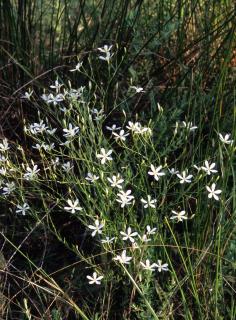Difference between revisions of "Sabatia brevifolia"
(→Description) |
(→References and notes) |
||
| Line 51: | Line 51: | ||
Florida State University Robert K. Godfrey Herbarium database. URL: [http://herbarium.bio.fsu.edu http://herbarium.bio.fsu.edu]. Last accessed: November 2015. Collectors: Loran C. Anderson, Robert K. Godfrey, R.A. Norris, Annie Schmidt, Cecil R. Slaughter, Rodie White. States and Counties: Florida: Liberty, Osceola. Georgia: Grady. Compiled by Tall Timbers Research Station and Land Conservancy. | Florida State University Robert K. Godfrey Herbarium database. URL: [http://herbarium.bio.fsu.edu http://herbarium.bio.fsu.edu]. Last accessed: November 2015. Collectors: Loran C. Anderson, Robert K. Godfrey, R.A. Norris, Annie Schmidt, Cecil R. Slaughter, Rodie White. States and Counties: Florida: Liberty, Osceola. Georgia: Grady. Compiled by Tall Timbers Research Station and Land Conservancy. | ||
| + | |||
| + | Radford, Albert E., Harry E. Ahles, and C. Ritchie Bell. Manual of the Vascular Flora of the Carolinas. 1964, 1968. The University of North Carolina Press. 836. Print. | ||
Revision as of 17:02, 8 February 2016
| Sabatia brevifolia | |
|---|---|

| |
| Photo taken by Gil Nelson | |
| Scientific classification | |
| Kingdom: | Plantae |
| Division: | Magnoliophyta - Flowering plants |
| Class: | Magnoliopsida – Dicotyledons |
| Order: | Gentianales |
| Family: | Gentianaceae |
| Genus: | Sabatia |
| Species: | S. brevifolia |
| Binomial name | |
| Sabatia brevifolia Raf. | |

| |
| Natural range of Sabatia brevifolia from USDA NRCS Plants Database. | |
Common name: shortleaf rose gentian
Contents
Taxonomic notes
Description
"Glabrous, perennial or annual herbs with erect or ascending stems. Leaves opposite, entire, sessile. Inflorescence terminal, cymose. Calyx 5-13 parted, lobes united at bae, those of first flowers longest, smaller on later flowers; corolla rotate white or pink with yellow eye, lobes 5-13, tube becoming membranous and persistent around the capsule. Capsule ovoid to ellipsoid; seeds small, alveolate." - Radford et al 1964
"Annual, rhizomes absent. Stems freely branched, terete or slightly angled above, 2-5 dm tall. Basal leaves present or absent at anthesis; stems leaves linear to narrowly lanceolate or elliptic-oblanceolate, 1-2.5 cm long, 1-8 mm wide, acute to obtuse. Inflorescence paniculate, branches alternate, to 3 dm long, 0.5-2.5 dm broad. Calyx lobes 5, linear, 2-7 mm long; corolla lobes white, usually white on drying, elliptic to oblanceolate, 1-1.5 cm long, 2-4 mm wide; filaments 1-2 mm long; stigmas 3-4 mm long, style 0-1 mm long. Capsule 4-5 mm long; seeds brown, 0.3-0.4 mm long." - Radford et al 1964
Distribution
Ecology
Habitat
In the Coastal Plain in Florida and Georgia, S. brevifolia can occur in wet pine flatwoods and moist sand around ephemeral ponds in open flatwoods (FSU Herbarium). Associated species Polygala cruciata, P. hookeri, P. lutea, Eupatorium leucolepis (FSU Herbarium).
Phenology
It has been observed flowering in September (FSU Herbarium).
Seed dispersal
Seed bank and germination
Fire ecology
Pollination
The following Hymenoptera families and species were observed visiting flowers of Sabatia brevifolia at Archbold Biological Station (Deyrup 2015):
Halictidae: Lasioglossum nymphalis
Use by animals
Diseases and parasites
Conservation and Management
Cultivation and restoration
Photo Gallery
References and notes
Deyrup, M.A. and N.D. 2015. Database of observations of Hymenoptera visitations to flowers of plants on Archbold Biological Station, Florida, USA.
Florida State University Robert K. Godfrey Herbarium database. URL: http://herbarium.bio.fsu.edu. Last accessed: November 2015. Collectors: Loran C. Anderson, Robert K. Godfrey, R.A. Norris, Annie Schmidt, Cecil R. Slaughter, Rodie White. States and Counties: Florida: Liberty, Osceola. Georgia: Grady. Compiled by Tall Timbers Research Station and Land Conservancy.
Radford, Albert E., Harry E. Ahles, and C. Ritchie Bell. Manual of the Vascular Flora of the Carolinas. 1964, 1968. The University of North Carolina Press. 836. Print.